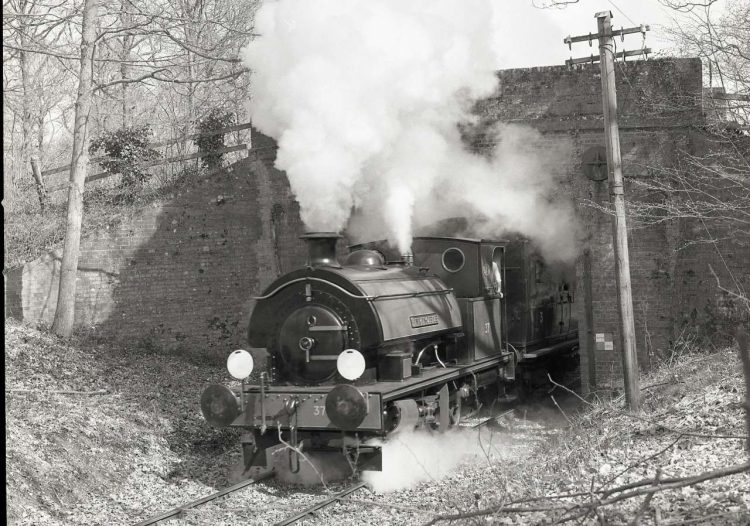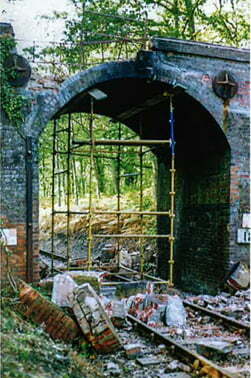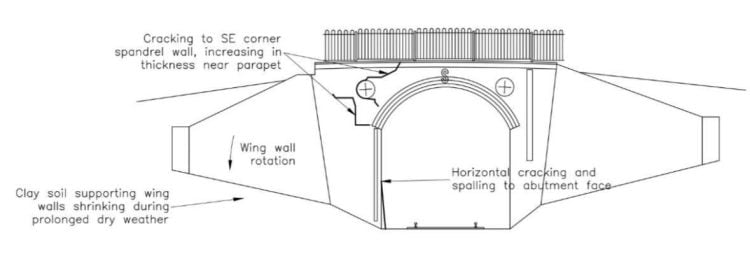The Isle of Wight Steam Railway (IWSR) is to remove one of its bridges, as it is in a dangerous condition and is no longer needed.
Bridge 12, located around 0.4 miles west of Havenstreet station, was built around 1875 by contractors building the Ryde and Newport Railway.
Its purpose was to allow the landowner to cross the line. However, the land either side of the railway is now owned by separate landowners and so the railway has no obligation to maintain the bridge as a link.
Bridge 12 has historical significance both to the line and the IWSR, as it was the only bridge crossing the line until the extension to Smallbrook opened.

Significant sections of the railway are constructed on clay subsoil, which is affected by ground movement during extremely dry or wet weather conditions. Bridge 12 sits on this clay subsoil and has suffered as a result of ground movement over a long period of time. Over the last 35 years, the Railway has had to spend a lot of time and money maintaining it, and in 1990 the Wootton section closed to traffic to enable urgent repairs. For the last two years, the bridge has been fenced off to prevent pedestrian access.
In February last year, the Railway’s Board discussed the situation, and considered initial assessments of the condition of the bridge and options for its future. Professional advice recommended that the Railway remove the bridge, as it could not be left to deteriorate further, and options for repairs and/or rebuilding would cost a lot of money, which might increase over time.
The Board asked for further information. While this was being sought, 2022’s dry summer in 2022 caused further movement, raising the risk of structural failure. In Autumn 2022, the Railway spent £7,000 on trial pits and borehole investigations, in order to better understand the stability of the foundations.

Last Saturday (9 September 2023), the Board considered all the reports placed before it, and the five options open to it:
- do nothing, or carry out minimal maintenance – the Board considered this to be not viable
- repairs: installing concrete beams under the track to support the bridge’s walls, then digging out the infill and creating a concrete saddle tied into the brick arch (cost: £100,000 plus contingency) – the Board felt that this was only a partial solution, would risk the arch falling during the work, and would leave the wing walls at risk of further movement
- replacement: the removal of the current structure in full, including the existing ‘below ground’ structure and a complete new build (cost: £350,000 plus contingency)
- replacement with a footbridge – cheaper than a full rebuild, but with no real benefit
- removal of the bridge: undertaken in house, within the closed season, along with raising the level of the trackbed to alleviate water saturation through the section.
The Board opted to record in full detail the current bridge and then remove it. This would allow the bridge to be rebuilt in the future. The dormouse crossing that sits above the structure of the bridge will be retained but it may be necessary to temporarily remove it during dismantling works.

Peter Taylor, Chair of the Isle of Wight Steam Railway, said, “Over the last two years, the board has carefully considered all options and sought professional advice. It was clear that none of the proposed repairs would act a permanent solution, and that the bridge would continue to require significant ongoing investment.
“The history and heritage aspects of Bridge 12 were very much in directors minds when evaluating the way forward. As one of the line’s original structures, there was naturally a hope that this aspect of the line’s heritage could be preserved. Nevertheless we recognise that the bridge is in poor condition and has been subject to many repairs over the years which have reduced how much of the bridge is original and altered its appearance. As trustees we felt that there were better uses of the charity’s funds, and that dismantling the bridge was ultimately in the best long-term interests of the Railway.
“Taking the decision to dismantle part of the line’s infrastructure was not taken lightly. As directors and trustees of the railway we needed to carefully weigh up the heritage, financial and safety implications. We’re fortunate the rest of the line’s bridges are in good condition, however Bridge 12 has long been problematic and deteriorated to the point where we can’t ignore its condition. In the first instance we will ensure that Bridge 12 is properly recorded by photographing and laser-scanning the structure, to act as a permanent record”.






Responses
The Trustee’s have made the correct decision.
Stop throwing good money after bad and take it down.
A shame. But if bricks can be salvaged and stored. Let’s hope a lottery grant in future will allow a full rebuild.
I understand the cost implications but, the bridge helps with the whole ambience of the old steam railway experience.
Will be a shame …..i thought the whole point was to save the historic railway, no matter what the cost
“No matter what the cost”… who’s going to foot the bill then, are you? The money would be better spent on something far more important than a tatty old bridge that nobody uses. In future, I suggest you make sure your brain is engaged before putting your mouth into gear. Think again!
If the railway doesn’t work commercially, it won’t be able to preserve anything.
What a rude response, Paul.
It’s a sign of a weak case, when it can’t be made politely.
I agree with you, Daz. I would like to see the bridge rebuilt as in its heyday, using as much original material as possible.
I feel the right decision has been made and the board of Trustees have made their choices and decision very public which is highly commendable.
A decision not taken lightly and , all options considered, the removal is the only realistic solution. I like the idea of using modern technology to form a lasting historical record. Is leaving a small section of the lower wall in place to celebrate the bridges location viable? Not high enough to be structural but just enough to mark the bridges position and remain as a feature of the line?
This is a good idea. Leave a standing monument in place noting the fact that the bridge was very early and part of the railway heritage. Keep the bricks etc in long-term storage for future use and as a historical document.
Sounds the best bet and leaves the possibility if required for a modern replacement sometime in the future.